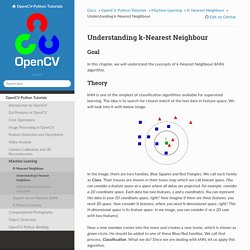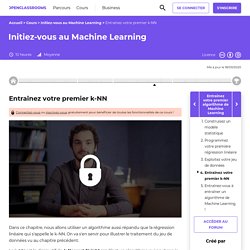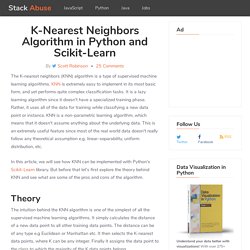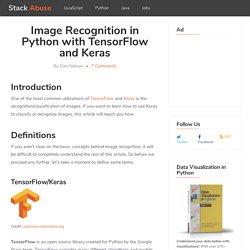

Understanding k-Nearest Neighbour — OpenCV-Python Tutorials 1 documentation. Theory¶ kNN is one of the simplest of classification algorithms available for supervised learning.

The idea is to search for closest match of the test data in feature space. We will look into it with below image. In the image, there are two families, Blue Squares and Red Triangles. We call each family as Class. Now a new member comes into the town and creates a new home, which is shown as green circle. One method is to check who is his nearest neighbour. But there is a problem with that. Again, in kNN, it is true we are considering k neighbours, but we are giving equal importance to all, right? So what are some important things you see here? You need to have information about all the houses in town, right? Now let’s see it in OpenCV. kNN in OpenCV¶ We will do a simple example here, with two families (classes), just like above. So here, we label the Red family as Class-0 (so denoted by 0) and Blue family as Class-1 (denoted by 1). Then we plot it with the help of Matplotlib. Feature Extraction Using Python. Entraînez votre premier k-NN - Initiez-vous au Machine Learning.
OK, on peut maintenant passer aux choses sérieuses !

Les données et la problématique D'abord, parlons du jeu de données que nous allons utiliser. C'est un dataset très célèbre, appelé MNIST. Il est constitué d'un ensemble de 70000 images 28x28 pixels en noir et blanc annotées du chiffre correspondant (entre 0 et 9). L'objectif de ce jeu de données était de permettre à un ordinateur d'apprendre à reconnaître des nombres manuscrits automatiquement (pour lire des chèques par exemple).
Notre objectif sera donc d'entraîner un modèle qui sera capable de reconnaître les chiffres écrits sur ce type d'images. From sklearn.datasets import fetch_openml mnist = fetch_openml('mnist_784', version=1) Le dataset peut prendre un certain temps à se charger, soyez patients. L'objet mnist contient deux entrées principales, data et target. . # Le dataset principal qui contient toutes les images. K-Nearest Neighbors Algorithm in Python and Scikit-Learn. The K-nearest neighbors (KNN) algorithm is a type of supervised machine learning algorithms.

KNN is extremely easy to implement in its most basic form, and yet performs quite complex classification tasks. It is a lazy learning algorithm since it doesn't have a specialized training phase. Rather, it uses all of the data for training while classifying a new data point or instance. KNN is a non-parametric learning algorithm, which means that it doesn't assume anything about the underlying data.
This is an extremely useful feature since most of the real world data doesn't really follow any theoretical assumption e.g. linear-separability, uniform distribution, etc. In this article, we will see how KNN can be implemented with Python's Scikit-Learn library. Theory The intuition behind the KNN algorithm is one of the simplest of all the supervised machine learning algorithms. Let's see this algorithm in action with the help of a simple example. Pros and Cons of KNN Pros Cons The Dataset Resources.
Image Classification using keras. Image Recognition in Python with TensorFlow and Keras. Introduction One of the most common utilizations of TensorFlow and Keras is the recognition/classification of images.

If you want to learn how to use Keras to classify or recognize images, this article will teach you how. Definitions If you aren't clear on the basic concepts behind image recognition, it will be difficult to completely understand the rest of this article. So before we proceed any further, let's take a moment to define some terms. TensorFlow/Keras Credit: commons.wikimedia.org TensorFlow is an open source library created for Python by the Google Brain team.
In terms of Keras, it is a high-level API (application programming interface) that can use TensorFlow's functions underneath (as well as other ML libraries like Theano). Image Recognition (Classification) Image recognition refers to the task of inputting an image into a neural network and having it output some kind of label for that image. Feature Extraction How Neural Networks Learn to Recognize Images Activation Functions.